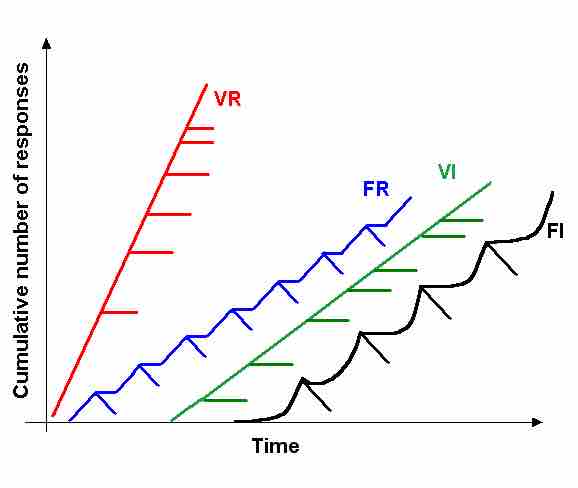A schedule of reinforcement is a tactic used in operant conditioning that influences how an operant response is learned and maintained. Each type of schedule imposes a rule or program that attempts to determine how and when a desired behavior occurs. Behaviors are encouraged through the use of reinforcers, discouraged through the use of punishments, and rendered extinct by the complete removal of a stimulus. Schedules vary from simple ratio- and interval-based schedules to more complicated compound schedules that combine one or more simple strategies to manipulate behavior.
Continuous vs. Intermittent Schedules
Continuous schedules reward a behavior after every performance of the desired behavior. This reinforcement schedule is the quickest way to teach someone a behavior, and it is especially effective in teaching a new behavior. Simple intermittent (sometimes referred to as partial) schedules, on the other hand, only reward the behavior after certain ratios or intervals of responses.
Types of Intermittent Schedules
There are several different types of intermittent reinforcement schedules. These schedules are described as either fixed or variable and as either interval or ratio.
Fixed vs. Variable, Ratio vs. Interval
Fixed refers to when the number of responses between reinforcements, or the amount of time between reinforcements, is set and unchanging. Variable refers to when the number of responses or amount of time between reinforcements varies or changes. Interval means the schedule is based on the time between reinforcements, and ratio means the schedule is based on the number of responses between reinforcements. Simple intermittent schedules are a combination of these terms, creating the following four types of schedules:
- A fixed-interval schedule is when behavior is rewarded after a set amount of time. This type of schedule exists in payment systems when someone is paid hourly: no matter how much work that person does in one hour (behavior), they will be paid the same amount (reinforcement).
- With a variable-interval schedule, the subject gets the reinforcement based on varying and unpredictable amounts of time. People who like to fish experience this type of reinforcement schedule: on average, in the same location, you are likely to catch about the same number of fish in a given time period. However, you do not know exactly when those catches will occur (reinforcement) within the time period spent fishing (behavior).
- With a fixed-ratio schedule, there are a set number of responses that must occur before the behavior is rewarded. This can be seen in payment for work such as fruit picking: pickers are paid a certain amount (reinforcement) based on the amount they pick (behavior), which encourages them to pick faster in order to make more money. In another example, Carla earns a commission for every pair of glasses she sells at an eyeglass store. The quality of what Carla sells does not matter because her commission is not based on quality; it’s only based on the number of pairs sold. This distinction in the quality of performance can help determine which reinforcement method is most appropriate for a particular situation: fixed ratios are better suited to optimize the quantity of output, whereas a fixed interval can lead to a higher quality of output.
- In a variable-ratio schedule, the number of responses needed for a reward varies. This is the most powerful type of intermittent reinforcement schedule. In humans, this type of schedule is used by casinos to attract gamblers: a slot machine pays out an average win ratio—say five to one—but does not guarantee that every fifth bet (behavior) will be rewarded (reinforcement) with a win.
All of these schedules have different advantages. In general, ratio schedules consistently elicit higher response rates than interval schedules because of their predictability. For example, if you are a factory worker who gets paid per item that you manufacture, you will be motivated to manufacture these items quickly and consistently. Variable schedules are categorically less-predictable so they tend to resist extinction and encourage continued behavior. Both gamblers and fishermen alike can understand the feeling that one more pull on the slot-machine lever, or one more hour on the lake, will change their luck and elicit their respective rewards. Thus, they continue to gamble and fish, regardless of previously unsuccessful feedback.

Simple reinforcement-schedule responses
The four reinforcement schedules yield different response patterns. The variable-ratio schedule is unpredictable and yields high and steady response rates, with little if any pause after reinforcement (e.g., gambling). A fixed-ratio schedule is predictable and produces a high response rate, with a short pause after reinforcement (e.g., eyeglass sales). The variable-interval schedule is unpredictable and produces a moderate, steady response rate (e.g., fishing). The fixed-interval schedule yields a scallop-shaped response pattern, reflecting a significant pause after reinforcement (e.g., hourly employment).
Extinction of a reinforced behavior occurs at some point after reinforcement stops, and the speed at which this happens depends on the reinforcement schedule. Among the reinforcement schedules, variable-ratio is the most resistant to extinction, while fixed-interval is the easiest to extinguish.
Simple vs. Compound Schedules
All of the examples described above are referred to as simple schedules. Compound schedules combine at least two simple schedules and use the same reinforcer for the same behavior. Compound schedules are often seen in the workplace: for example, if you are paid at an hourly rate (fixed-interval) but also have an incentive to receive a small commission for certain sales (fixed-ratio), you are being reinforced by a compound schedule. Additionally, if there is an end-of-year bonus given to only three employees based on a lottery system, you'd be motivated by a variable schedule.
There are many possibilities for compound schedules: for example, superimposed schedules use at least two simple schedules simultaneously. Concurrent schedules, on the other hand, provide two possible simple schedules simultaneously, but allow the participant to respond on either schedule at will. All combinations and kinds of reinforcement schedules are intended to elicit a specific target behavior.